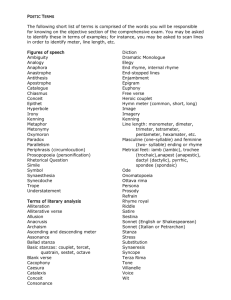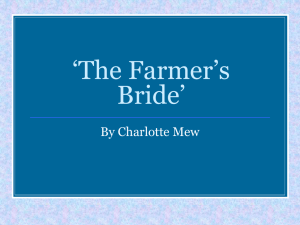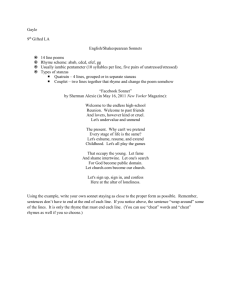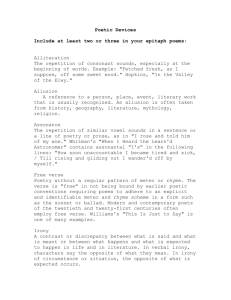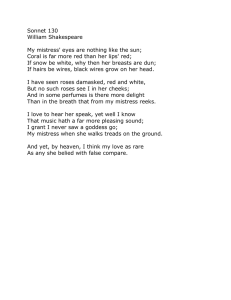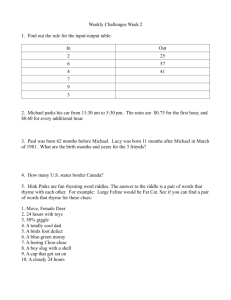Poetry Terms
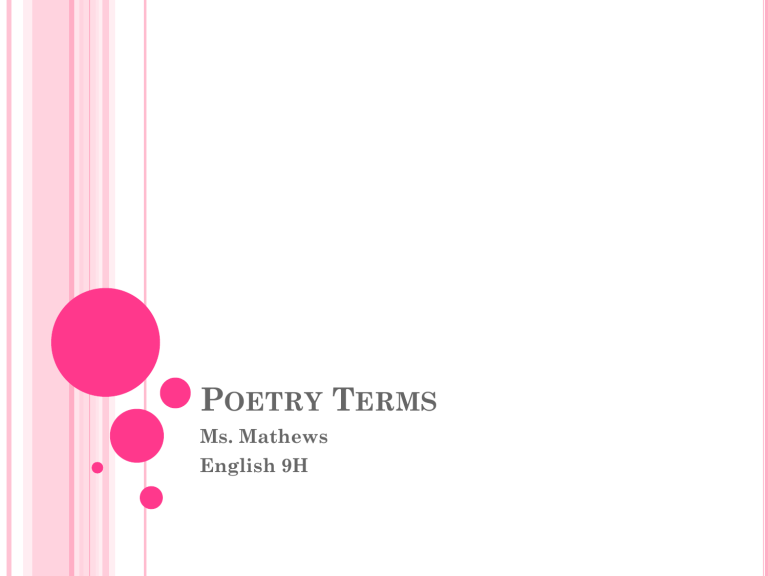
P OETRY T ERMS
Ms. Mathews
English 9H
T YPES OF P OEMS
V ERSE
Rhymed Verse
the most commonly used form of verse generally has an end rhyme
Blank Verse
generally identified by a regular meter, but no end rhyme
Free Verse
usually defined as having no fixed meter and no end rhyme
E XAMPLE OF R HYMED V ERSE
I wandered lonely as a cloud:
That floats on high o'er vales and hills
When all at once I saw a crowd,
A host, of golden daffodils;
Beside the lake, beneath the trees
Fluttering and dancing in the breeze.
-William Wordsworth
E XAMPLE OF B LANK V ERSE
In Mathematics, Woman leads the way:
The narrow-minded pedant still believes
That two and two make four! Why, we can prove,
We women-household drudges as we are-
That two and two make five-or three-or seven;
Or five-and-twenty, if the case demands!
-Anonymous
E XAMPLE OF F REE V ERSE
I remember the days of dreamings,
From where in the world so much knowledges,
And thoughts of wonderful and funs.
But however life walks ahead,
And ideas are unavailing aloud,
When around so many flies.
Concealed after the masks of sorrow.
-Anonymous
N ARRATIVE
Tells a story
Includes the following elements:
Characters
Setting
Plot
Point of View
All the elements combine to form a theme
Example: The Odyssey
B ALLAD
Tells a story
Meant to be sung or recited
Typically depict ordinary people in the midst of tragic events or adventures of love and bravery
Example: “The Ballad of Birmingham”
L YRIC
A short poem in which the speaker expresses personal thoughts and feelings
Most poems, with the exception of narratives, are lyric poems
Cover many subjects, from love to death to everyday experiences
Example: “Theme for English B” by Langston
Hughes
E PIC
A long narrative poem about the adventures of a hero whose actions reflect the ideals and values of a nation or race
Address universal concerns, such as:
Good and evil
Life and death
Sin and redemption
Example: The Odyssey
S ONNET
A lyric poem of 14 lines
Most common is the Shakespearean sonnet
made up of three quatrains (four line units) and a final couplet
has a rhyme scheme of abab cdcd efef gg
Example: “Sonnet 140” by William Shakespeare
P OETIC E LEMENTS
A NALOGY
A point-by-point comparison between two things that are alike in some respect
Are often used in nonfiction, when an unfamiliar subject or idea is explained in terms of a familiar one
R HYME
The occurrence of a similar or identical sound at the ends of two or more words
Example: suite, heat, complete
Internal rhyme
Occurs within the line
End rhyme
Occurs at the end of the line
Slant rhyme
Also called approximate or near rhyme
Occurs when the sounds are not quite identical
Example: care and dear
R HYME E XAMPLES
Internal
Once upon a midnight dreary , while I pondered weak and weary
While I nodded, nearly napping , suddenly there came a tapping
External
Humpty Dumpty sat on a wall ,
Humpty Dumpty had a great fall .
All the King's horses, And all the King's men
Couldn't put Humpty together again !
Slant
I sat in the dark nursing my broken heart .
M ETER
The regular pattern of accented and unaccented syllables in a line of poetry
R HYTHM
Refers to the pattern or flow of sound created by the arrangement of stressed and unstressed syllables in a line of poetry
T ONE
The attitude a writer takes towards a subject
Reflects the feelings of the writer
O XYMORON
A figure of speech that combines contradicting words
Examples:
Bitter sweet
Forward retreat
Serious joke
Deafening silence
A LLITERATION
The repetition of consonant sounds at the beginnings of words
Example using the h sound:
“The angels, not h alf so h appy in H eaven,
Went envying h er and me;”
-Edgar Allan Poe, from “Annabel Lee”
H YPERBOLE
The use of exaggeration
May be used to evoke strong feelings or to create a strong impression
Not meant to be taken literally
Examples:
I’m so hungry that I could eat a horse!
That bag weighs a ton.

